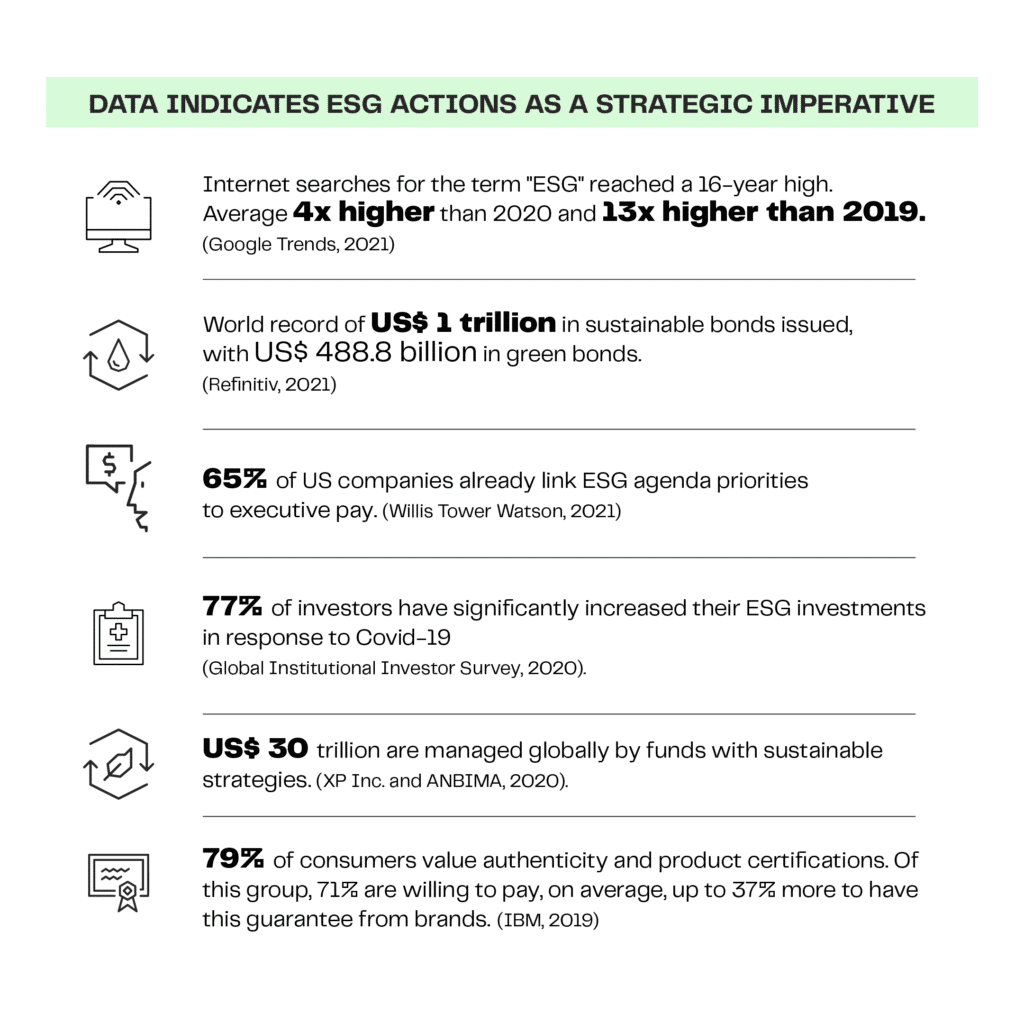By EloInsights, in collaboration with Lays Lobato
- In the new economy, operational excellence and the ability to innovate need to be linked to a powerful sense of purpose, which can be used by consistent ESG practices.
- Cultivating ESG practices means acting responsibly in relation to the environment, social causes and corporate governance. Above all, it relates to creating and sustaining long-term value.
- We highlight four levers that materialise the power and gains generated by supporting fertile soil for ESG actions: brand reputation, risk and cost reduction, business opportunities, culture and intrinsic value.
An important part of the new management paradigm is integrating operational excellence, innovation and a powerful sense of purpose capable of linking all this to the engagement of employees, board members, suppliers, consumers and the hole society in general. In this context, the topic of ESG [Environmental, Social and Corporate Governance] has come to the fore as companies that act responsibly towards the environment, society and their own management gain ground.
Consumers, managers, shareholders and investment funds are turning their attention to those who cultivate ESG practices. Planting these seeds shows, above all, the ability to create and sustain long-term value by managing risks and seizing opportunities associated with current and predicted environmental, social and economic transformations.
Various contexts and factors contribute to making this movement necessary and possible for companies. It reflects the desires of a new generation that recognizes its diversity and the social inequality that plagues countless communities. It is made up of individuals who are strongly guided by a logic of conscious consumption, the preservation of natural resources and warnings about climate change.
Lines of credit and structures for financing businesses and initiatives with a social and environmental impact are flourishing and more fund managers are giving importance to ESG issues. In 2020, US$30 trillion were already managed in funds with sustainable strategies, 50% in the United States and 25% in Europe. In 2021, the total issuance of sustainable bonds worldwide hit an all-time high, surpassing US$1 trillion for the first time. Compared to 2020, this was an increase of 45%. Looking at green bonds, there were US$ 488.8 billion issued to finance projects aimed at the environment – almost double from the year before.
Areas of innovation, research and development are betting on products and services to serve underserved markets, even if this initially means a reduction in profitability. Large corporations are working to positively change the entire production chain, with defined causes, responsibly distributing the profits generated, rigorously selecting suppliers and promoting diversity and inclusion.
In addition to these movements, the pandemic has redefined the world panorama in recent years, with deep crises not only due to the collapse of health systems, but also on the economic side, with rising unemployment and a wake of social problems. The notion that solving chronic problems involves reinventing models of cooperation has been combined. It is only possible to deliver real transformation – at scale, speed and maximum impact – with capacity building, intersectoral collaboration and public-private partnerships between companies, governments, civil organizations and academies.
More than directing funds, this new model requires the creation of networks and ties. Actions gain shape and purpose when there is a real rapprochement between organizations and the territories, issues and people they serve. It is necessary to develop active listening on the part of the government relations and social responsibility areas of companies to perpetuate results, molding capacities in a collaborative construction between technical teams and beneficiaries.
The requirement is to take a serious look at the changes we are experiencing and how we can contribute, as individuals or as organizations, to building a better world. It is only possible to reap the rewards of the seeds planted by continually tending to the soil, and the best strategy is to connect ESG actions with levers that take root and sustain healthy relationships over the long term.

Four main ESG levers
We have come a long way in recent years. Today it is possible to have a broader understanding of the need for ESG issues to be intrinsically linked to the activities of each and every organization, but it is still difficult to make the value generated by adopting these practices tangible.
We need to make progress in building metrics and systems that transparently monetize the enormous correlation that exists between the financial and non-financial performance of organizations. In other words, the externalities and impacts generated positively or negatively by organizations in the environmental and social spheres.
Besides this challenge, ESG aspects cover diverse themes and have a different center of gravity and relevance for each business, making a rigid, one-size-fits-all approach unfeasible.
In this context, our mission as a tranformational consultancy – which relies on the integration of Technology, Analytics and Management (TAM) – with cross-sector operations in a variety of industries, is to support our clients in building and analyzing their materiality matrices and vision of the future in order to design actions that drive greater potential for capturing value in the medium and long term, above all, taking into account business risks and opportunities.
To exercise our ESG lens, here are four levers that we generally use to guide sustainability discussions within organizations:

1. Corporate reputation
Generating value from the perspective of corporate reputation has significant impacts that can reverberate in attracting new clients, business partners, suppliers and investors. This, in turn, generates a potential increase in revenue, impact and the scale of products, programs and services.
Beyond these issues, a good corporate reputation favors institutional relations with society and governments. This can be crucial in keeping and expanding the operations of companies in strategic locations.
It is important to emphasize that actions that trigger ESG levers can be aimed at generating positive impact or mitigating negative impacts. However, focusing on positive impacts is much more effective in using a corporation’s image.
This is the case with the social arm of a Brazilian holding company that encourages its conglomerate to get involved in the creation of a health support fund. For every R$1 invested by the group’s companies, the institute contributes another R$1. This way, it is possible to finance more projects, reach more territories, transform the reality of many people and even combine and polish relationships with different communities.

2. Reducing risks and costs
Reducing risks and costs connects the adoption of ESG practices to the amortization of fines and penalties, since it consequently goes hand in hand with compliance with protocols and legislation.
Changing the layout of a factory with a view to the conscious use of natural resources, such as water and energy, while reducing overall costs, benefits the environment. The same goes for industries that invest in waste disposal, which can bring more savings in the purchase of inputs and raw materials.

3. Business opportunities
Another important lever is identifying new markets, clients, products, services and revenue streams. This is the sweet spot that all organizations would like to be in, the quadrant of the matrix where conceptually we have shared value, and socio-environmental challenges are also a business opportunity.
For example, a food delivery app focused on the volume of disposables generated, especially in the context of the pandemic. In its large network of food distributors, many do not have the size to buy biodegradable disposables. The solution was to create a business line to supply these materials at an affordable cost.
This level relates both to adapting business models and environmental and regulatory changes – generating competitive advantage in the market in the long term – and to greater access to resources, investment funds and subsidies.

4. Culture and intrinsic value
ESG is one of the major themes of Generation Z, which values the plurality of experiences and the common good, with special concern for the condition of the planet. For this reason, this lever is related to attracting and retaining talent, clients and investors as your company has well-defined values, works on the notion of purpose, engages in environmental preservation and seeks ways to reduce inequalities.
Numerous studies have shown an increase in productivity and engagement when a group or structured volunteering program is set up to enable close contact with communities and areas of influence of large corporations. It also fits into a logic of resilience and identification, since the focus is on the medium and long term.
From a broader viewpoint, the levers can be worked on concurrently; an action can trigger more than one ESG lever and thus broaden the result and scope of the impact. What is more, in terms of the spectrum of impact – from local to societal – you can first change the company and then invest in an impact action for the whole chain, or you can start in a more holistic and integral way, covering the whole of society.
The strength and scope of the actions depend on the maturity and capacity of each organization. The important thing is to move towards sustainability. More than ever, it is time to take a step forward or get out of the way.

Connection for the future of business
The essence of new people and management models unites two worlds: operational excellence and innovation, both driven by a keen sense of purpose. This combination has a direct link to the promotion of ESG in large corporations interested in surviving the transition to the future, the regeneration of capitalism.
Changing the mindset for this new world, where only those who focus on the sustainability of their actions survive, means placing yourself as part of society, valuing people and thinking about the common good of this and the next generations.
LAYS LOBATO works as Partner and Director at EloGroup.











